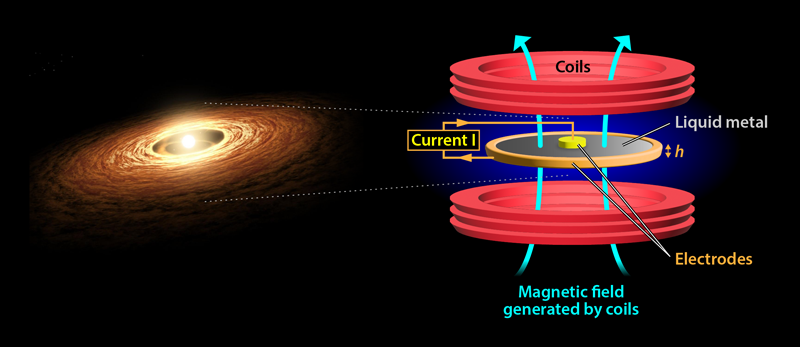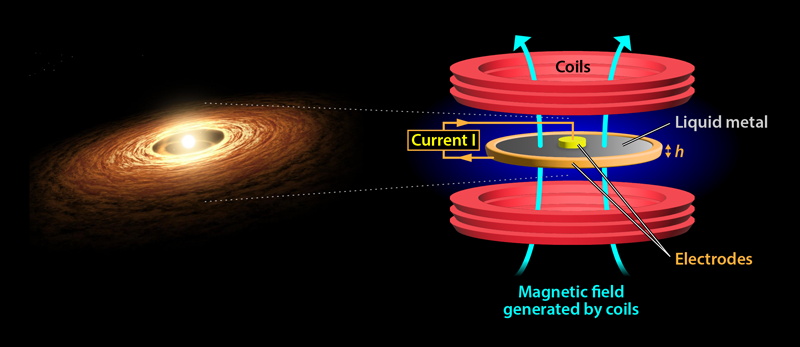Liquid Metal Experiment Mimics Accretion Disks
Astrophysical disks are ubiquitous objects in the cosmic landscape: we observe them around matter-gobbling black holes and planet-forming stellar systems. The gas and dust in these disks slowly drift inward and eventually reach the central star or black hole. The energy released in this accretion process makes some of these disks very luminous. However, the physical mechanism responsible for this accretion remains elusive despite 40 years of active research. Now Marlone Vernet from Sorbonne University in France and his colleagues model astrophysical disks with an experimental system based on a rotating disk of liquid metal [1]. The novelty in this experiment is that the disk is set into rotation thanks to electrical currents and magnetic fields in a way that mimics gravity. The experiment provides strong evidence of angular momentum transport, which is thought to be a key feature in astrophysical accretion. Their results provide new upper bounds on parameters related to the accretion mechanism and could help to improve our understanding of black hole environments and planet formation.
For accretion to happen, the material that makes up a disk needs to lose its angular momentum. The inward accretion of gas—toward the center of the disk—must therefore be associated with some outward transport of angular momentum. A plausible mechanism for angular momentum transport is through viscous friction. To illustrate this, one can imagine the disk being divided into concentric rings, or annuli. Each ring rotates at a different speed, causing neighboring rings to “rub” against each other. If the gas is viscous, then this rubbing can allow rings to pull on each other in a way that transfers angular momentum outward [2]. However, the intrinsic gas viscosity is orders of magnitude too low to explain the observed accretion rates. Astrophysicists therefore assume that the gas is turbulent, which is usually modeled as a “turbulent” viscosity that enhances angular momentum transport [3]. While the viscous disk model is a very powerful tool, the origin of this turbulence remains a central problem in modern theoretical astrophysics.
Several mechanisms have been proposed to explain turbulence in astrophysical disks, from purely hydrodynamical processes to magneto-hydrodynamical instabilities [4, 5]. Most of our knowledge of these processes comes from numerical simulations, but there are always uncertainties about how realistic these simulations are. An alternative route is to devise experimental analogs. The most common one is the Taylor-Couette (TC) apparatus [6], a disk-shaped device with rotating inner and outer cylinders. Researchers place a liquid (usually water) between the cylinders and observe its rotation. By carefully choosing the rotation speed of each cylinder, this approach can generate a radial velocity profile in the liquid that mimics that of astrophysical disks.
However, TC devices are not perfect analogs of astrophysical disks. First, one needs to prevent water from leaking by adding caps to the top and bottom of the cylinders. These end caps, which don’t have a counterpart in astrophysical settings, lead to secondary flows that possibly trigger turbulence [7]. Second, the flow in a TC apparatus is set into motion by viscous friction with the cylinders (a surface forcing); while real astrophysical disks are set in rotation by gravity (a volume forcing). This difference affects the efficiency of angular momentum transport in the two systems.
The experimental apparatus presented by Vernet’s team partially alleviates these difficulties. In a liquid metal contained in a cylindrical disk, they apply a vertical magnetic field using coils above and below the disk while generating a radial electrical current in the liquid with electrodes (Fig. 1). The end result is an azimuthal electromagnetic force that causes the entire disk to rotate. Secondary flows due to the end caps are still present, as in classical TC, but the magnetic field strength allows the researchers to control and reduce their influence.
By changing the magnetic field and the electric current, Vernet and his colleagues are able to tune both the liquid’s rotation speed and the level of turbulence. They measure fine-scale fluctuations in flow speeds and directions using sensors placed at different locations in the liquid. Those measurements show that the turbulence itself leads to an outward angular momentum transport. Moreover, the team finds that even in the limit of zero intrinsic viscosity (the “ultimate” regime, so named by Robert Kraichnan in the 1960s), the flow still transports angular momentum outward. Hence, the experiment demonstrates that turbulent-driven momentum transport is possible in astrophysical disks—the missing piece for explaining inward mass transport of gas and dust. Unfortunately, the liquid-metal turbulence is produced by secondary flows in the experiment (that are absent from astrophysical disks), hence it does not pinpoint the origin of this turbulence in nature.
This exciting experiment has, for the first time with liquid metals, provided an empirical measurement of the amount of momentum transport in a nonviscous fluid. With more measurements like this, researchers could eventually obtain a laboratory-based estimate of the turbulence intensity that should be expected in observations of astrophysical disks. These intensity values can now be compared to ones obtained in numerical simulations [8], and have recently been inferred in Atacama Large Millimeter/submillimeter Array (ALMA) observations of a protoplanetary disk in our Galaxy [9, 10].
References
- M. Vernet et al., “Angular momentum transport by Keplerian turbulence in liquid metals,” Phys. Rev. Lett. 129, 074501 (2022).
- D. Lynden-Bell and J. E. Pringle, “The evolution of viscous discs and the origin of the nebular variables,” Mon. Not. R. Astron. Soc. 168, 603 (1974).
- N. I. Shakura and R. A. Sunyaev, “Black holes in binary systems. Observational appearance,” Astron. Astrophys. 24, 337 (1973).
- S. Fromang and G. Lesur, “Angular momentum transport in accretion disks: a hydrodynamical perspective,” EAS Publications Series 82, 391 (2019).
- S. A. Balbus and J. F. Hawley, “Instability, turbulence, and enhanced transport in accretion disks,” Rev. Mod. Phys. 70, 1 (1998).
- G. I. Taylor, “Fluid friction between rotating cylinders I—Torque measurements,” Proc. R. Soc. Lond. A 157, 546 (1936).
- J. M. Lopez and M. Avila, “Boundary-layer turbulence in experiments on quasi-Keplerian flows,” J. Fluid Mech. 817, 21 (2017).
- J. B. Simon et al., “Origin of weak turbulence in the outer regions of protoplanetary disks,” Astrophys. J. 865, 10 (2018).
- K. M. Flaherty et al., “Weak turbulence in the HD 163296 protoplanetary disk revealed by ALMA CO observations,” Astrophys. J. 813, 99 (2015).
- K. M. Flaherty et al., “A three-dimensional view of turbulence: Constraints on turbulent motions in the HD 163296 protoplanetary disk using DCO+,” Astrophys. J. 843, 150 (2017).





